Nowadays, I am more afraid of fishes than crocodiles, because fishes have teeth, humans like teeth. Omg! It’s scary to swim with them because they’re gonna catch swimmer balls-don’t mind, That’s true and really happened.
You’ll know why in this article.
In this article, We shall look at Animals with Human-like Teeth, In terms of appearance, numbers, occurrence, and shape.
Table of Contents
What Animals Have Similar Teeth To Humans?
There are many animals that have human teeth, In terms of appearance, same numbers, Heterodont conditions, Diphyodont conditions.
Sheepshead Fish

Number of teeth: 32 teeth.
Heterodont: Yes
The sheepshead, also called the convict fish, is a marine fish with human-like front teeth found in North American marine, Massachusetts, Florida.
These fishes have human-like teeth. They have 32 teeth, prominent incisors at the front jaw, three rows of molars in the upper jaw, two rows of molars in the lower jaw. Combination of these kinds of sharp and strong tooth aid in breaking the shells of captured prey such as barnacles, clams, fiddler crabs, crustaceans, and oysters.
Horse

Teeth Number: 36-44 teeth.
Heterodont: Yes.
The horse is a strong one-toed mammal evolved to run and is able to sleep while standing and lying on the land. These animals come in different varieties, heights, colors.
Horses usually have 36-44 teeth that are distributed in both upper and lower jaws. They are heterodonts, which means they have different shaped teeth for different needs. It has 12 incisors(6 in upper and 6 in lower jaws), 24 teeth (12 premolars and 12 molars), and other wolf teeth and tush teeth.
Its teeth continuously grow that can be used to find horse age as it slows down growing and the angle of lower and upper jaw incisor teeth changes with aging.
Giraffes

Teeth Number: 32 (Same as human: In numbers only)
Heterodont: Yes.
The giraffe is the tallest currently known herbivorous terrestrial mammal in the world and is found in Africa, and other countries as well, where they inhabited savannahs, and woodlands.
Upon comparing, Humans and giraffes, Both possess 32 teeth, But giraffes all 32 teeth are located in their lower jaw only. However, Its teeth are located in the back of its mouth which along with a long tongue and upper jaw a palate grinds the foods such as acacia leaves, and other plant derivatives.
Dog

Teeth Number: 42 teeth
Heterodonts: Yes (Different shaped teeth)
The domestic dog is a friendly mammal and is a direct descendent of the gray wolf. Similar to humans, dogs also have diphyodont teeth and incisors, canine teeth premolar, and molars that all vary by numbers. Adult dogs have 42 teeth. Among these 42 teeth, It is easily understood by its dental formula 3.1.4.2/3.1.4.3 (upper/lower jaw).
Interestingly, Its 42 teeth are unequally distributed, 20 in the upper jaw, and 22 on the lower jaw.
Are dogs teeth the same as humans? No, humans and dogs have different numbers of teeth (Human:32, Dog:42). However, Humans and dogs are the same as they both are diphyodont. Occurence of two sets of teeth in a lifetime, First milk or deciduous teeth and second adult or permanent teeth.
OMG! I fear more fish than the crocodile because fishes have teeth too.
Pacu Fish

Pacu is a freshwater fish found in South American, Brazil, and Amazon. Pacus are related to carnivorous fish called Piranha.
Pacu has teeth that resemble human teeth as its teeth are squarer, straighter teeth meant for crushing nuts, invertebrates, and fruits. However, they attacked the testicles of swimmers since they had mistaken the balls as nuts. This act gave them the name ‘ball-cutter’.
Pacus are legal to keep in the aquarium as pets in the US but the problem is they can grow as long as 4 feet and that frightens us as they are going to have big teeth too. Make sure your children and pets stay away from them.
Pigs
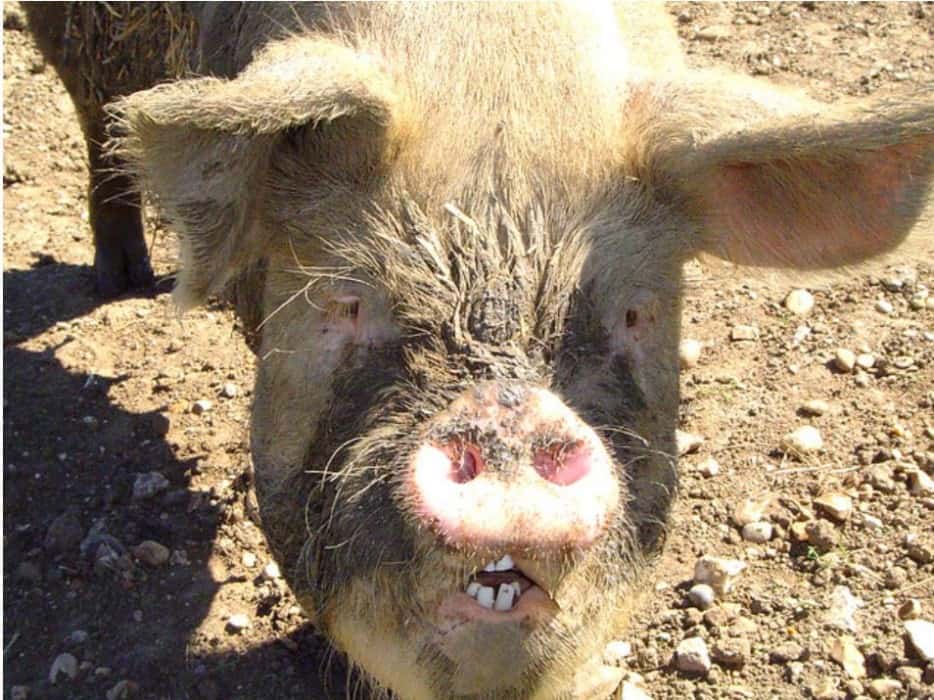
Teeth Number: 44 teeth
Heterodonts: Yes (Different shaped teeth)
A pig is an omnivorous mammal found across the world and inhabited forests, villages, semi-urban cities, also in farms for meat production. Both humans, and pigs are Heterodonts, that is they have different shapes of teeth to perform different functions but don’t have the same number of teeth as compared to humans.
Adult pigs have a total of 44 teeth that are evenly distributed into both upper and lower jaws. 12 incisors, 4 canines that can be grown to form tusks, 16 premolars, 12 molars situated back of their mouth. Thus the dental formula of adult pigs 3.1.4.3/3.1.4.3 (Upper/Lower Jaw).
Pig babies are called Piglets, Have ‘needle teeth’ as deciduous third incisor and canine teeth. These teeth are removed as they are usually found to hurt themselves and other piglets and sow.
Cow
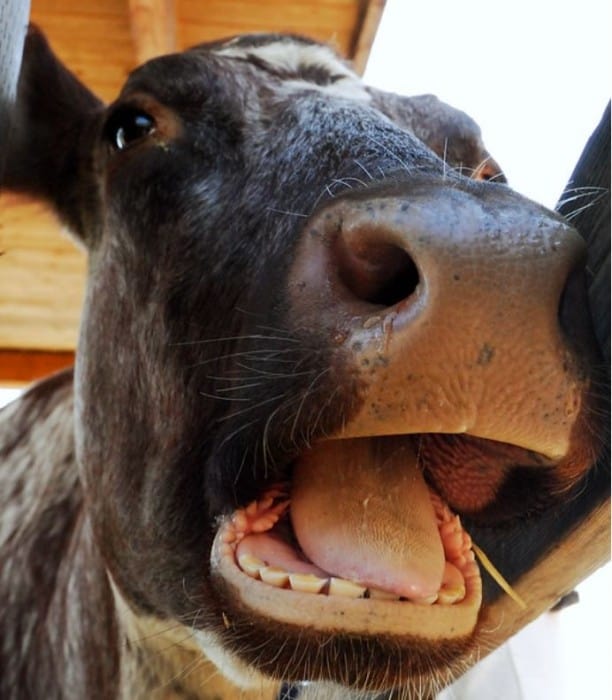
Teeth Number: 32 teeth
Heterodonts: Yes (Different shaped teeth)
The cow is a herbivorous domesticated mammal found across the world.
Humans and Cows are Diphyodont and Heterodonts that are the same in number but differ only in shapes and types. An adult cow has 32 teeth called permanent or adult teeth. They are incisors, premolars, and molars, the combination of premolars, and molars are known as cheek teeth. A baby cow has 20 teeth called temporary teeth, deciduous, milk, or simply baby teeth.
Surprisingly, Cows can’t bite you because they lack front teeth or incisors in the upper jaw.
Are cows teeth similar to humans? No, because cows don’t have incisors in their upper jaw while humans have incisors in their upper jaw.
However, Both cows and Humans have a number of teeth-32 teeth, and both have diphyodont, which is an occurrence of two sets of teeth in their lifespan, Milk teeth and adult teeth. They have Heterodonts as well.
Moose
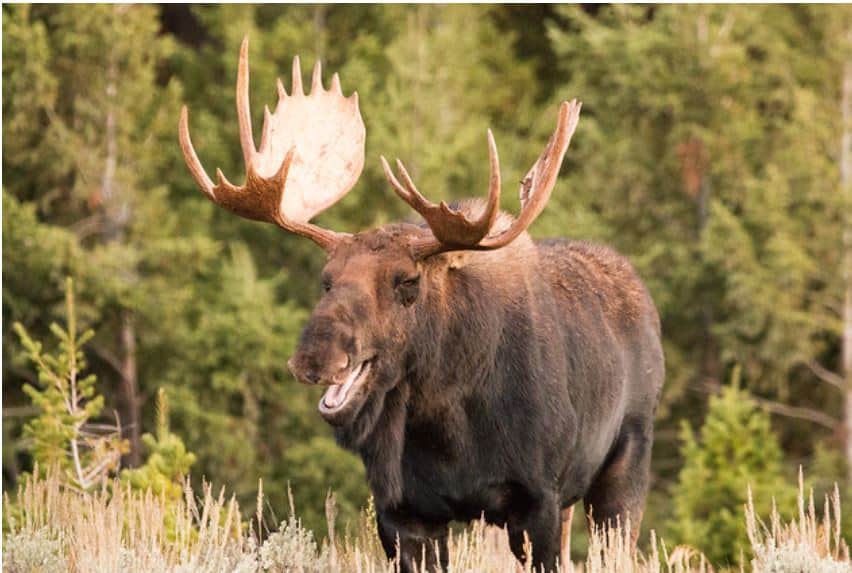
Teeth Number: 32 teeth
Heterodonts: Yes (Different shaped teeth)
The moose, also known as elk, wapiti, is a browsing herbivorous mammal related to the deer family found in the United States, Washington, and Canada.
Like humans, Moose has a similar number of 32 teeth and heterodont condition. Among 32 teeth, 6 incisors, 2 canines, 12 premolars, and 12 are ridged molars. While they lack teeth in their upper jaw.
Gorilla
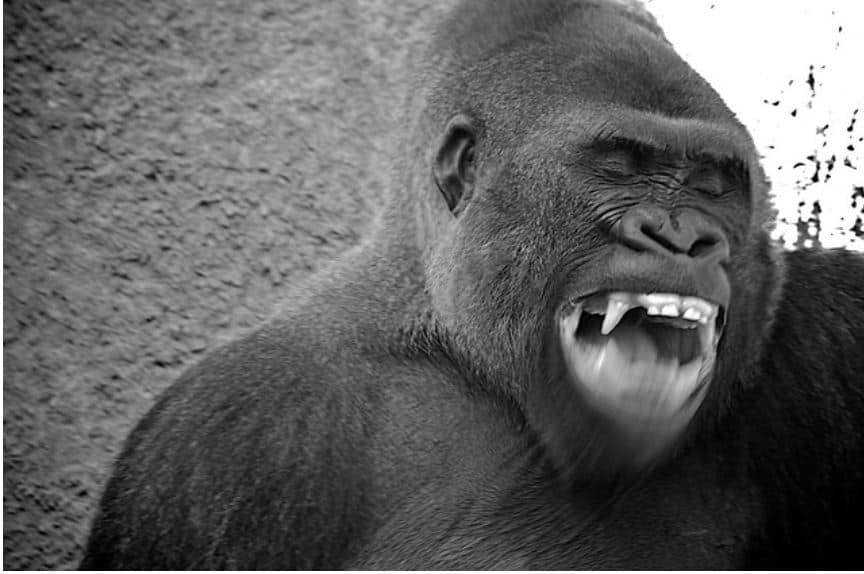
Teeth Number: 32 teeth.
Heterodonts: Yes (Different shaped teeth)
Comparatively humans and gorillas have the same number of teeth, 32 teeth, But stronger teeth belong to Gorillas as part of their coarse vegetation diet. Among 32 teeth, 8 incisors, 4 canine, 8 premolars, and 12 molars, that makes Its dental formula as 2,1,2,3/2,1,2,3(Upper/Lower jaw)× 2 = 32. Thus both Gorillas and Humans have heterodont, and diphyodont conditions, where two sets of teeth occur in their lifetime.
All of these teeth are stronger and usually larger than a human’s corresponding teeth. For example, Its canine is longer, about 2 inches and sharper than humans, and used to defend against other male gorillas, to build dominance, and to scare off predators.
Bonobo
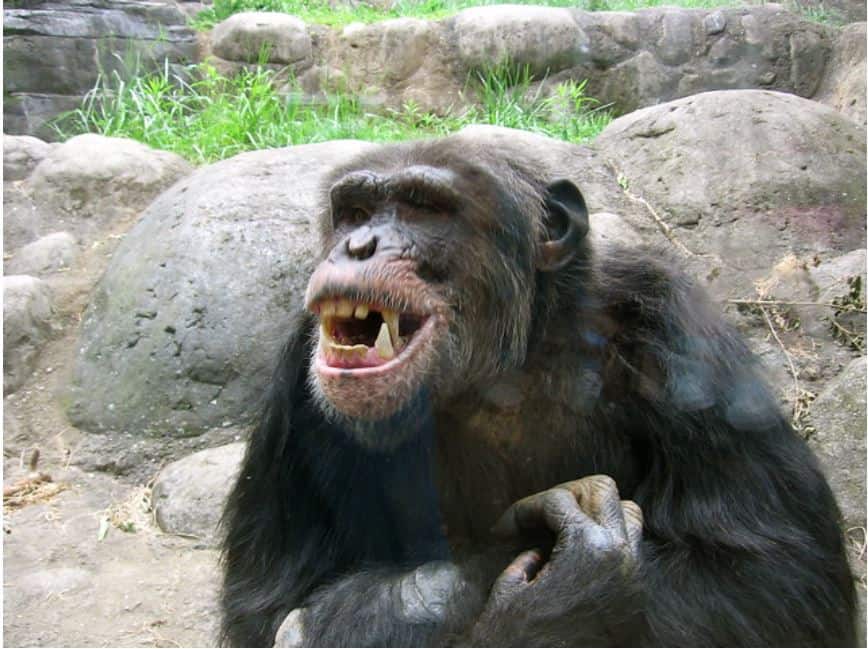
Teeth Number: 32 teeth
Heterodonts: Yes (Different shaped teeth)
The bonobo is a bipedal ape that belongs to the Hominidae family found in the Democratic Republic of Congo, and other places such as the zoo.
Humans along with Bonobo have 32 teeth, among 32 teeth, there are 8 incisors, 4 canine, 8 premolars, and 12 molars, give you a bonobo dental formula 2.1.2.3/2.1.2.3(Upper/Lower Jaw)
Chimpanzee
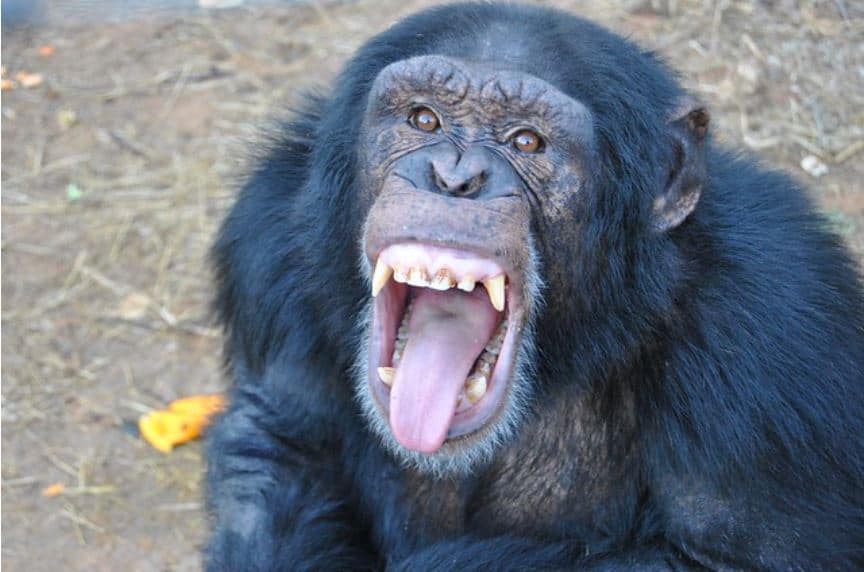
Teeth Number: 32 teeth
Heterodonts: Yes (Different shaped teeth)
The chimpanzee, also known as simply chimp, the common chimpanzee, the robust chimpanzee is an intelligent species belonging to the great ape and is found in Africa.
Humans and other apes have the almost same teeth, Similarly Chimps have the same dental formula and same diphyodont, heterodont condition as well. Thus its dental formula of 2.1.2.3/2.1.2.3(Upper/Lower jaw) results in about 32 teeth.
Also Read : Animals With Big Teeth
Which Animals Have The Same Number Of Teeth As Humans?
Giraffes, Sheepshead, Cow, Moose, Gorilla, and Bonobo, all these animals have 32 teeth like Humans.
Even though they have the same number of teeth they are not similar in function, location, shape. For example, Giraffes have 32 the same number of teeth as humans but all 32 teeth are present only in the lower jaw. There are no teeth present in their upper jaws.
Cows have 32 teeth like Humans, but they don’t have Incisor in their upper jaws while humans have incisors in their upper jaws.Sheepshead have 32 teeth, like humans, but it have 3 rows of teeth in their upper jaws, while humans have 2 rows of teeth.
Moose have 32 teeth, like humans do, but they lack teeth in their upper jaw, whereas Humans have teeth in both of the upper and lower jaws.
Do animals and humans have the same teeth? No, Not all animals and humans have the same teeth because teeth vary in animals and humans by having different location, shape, number, size, homodonts, heterodont, Monophyodont, and diphyodont conditions.
Differ by Location:
However, some animals such as Giraffe, Sheepshead, Cow, Moose, might have the same number of teeth like humans but not the same in terms of jaw location, that is they don’t have some teeth in upper jaws, or completely lack them.
Differ by size, shape, function and strength:
There are some animals, especially apes like Gorilla, Bonobo, that have the same number of teeth along with the same dental formula, the same in diphyodont and heterodont conditions like Humans.
However, When it comes to strength, function, shape and size, There are noticeable differences present. For instance, Gorillas have stronger and larger teeth than Humans, even though both have the same number of teeth and same diphyodont and heterodont conditions.
Homodonts conditions vs Heterodont conditions:
Animals may have Homodonts conditions, where only one kind of tooth occurs in them throughout their lifespan. For example, fish, amphibia.
Whereas, Humans have Heterodont conditions, where there are many kinds of tooth possible that vary by shape and size leading to different functions.
Monophyodont conditions vs Diphyodont conditions vs Polyphyodont:
Animals may have Monophyodont conditions, Where there is a single tooth set present throughout its life.For example, male narwhal, walruses, and seals.
Whereas, Humans have Diphyodont conditions, Where there are two sets of teeth that are going to occur in its lifetime, First tooth set called Milk, Deciduous teeth, and is replaced by a second tooth set called permanent or Adult teeth.
Polyphyodont are the animals that can replace their teeth many times in their lives. For example, manatees, elephants, and kangaroos keep replacing their worn or lost teeth continuously.
